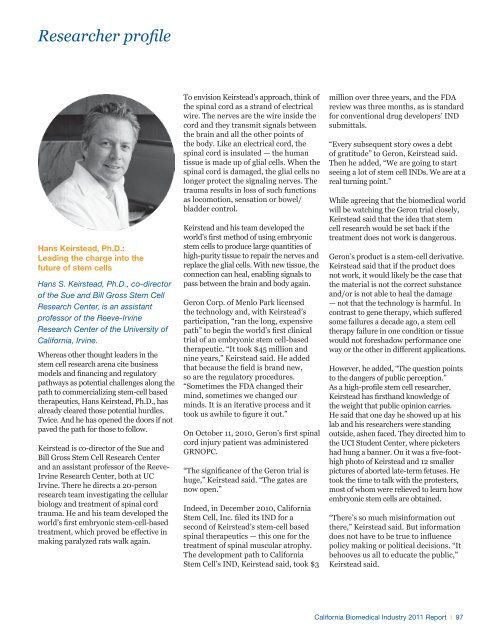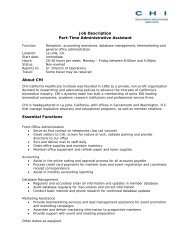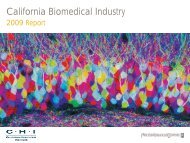Stem cell research innovation: Scientific breakthroughs coming one after anotherReverting adult cells to anembryonic-like stateWhile other researchers were focusedon triggering embryonic stem cells tobecome specific replacement tissues,Shinya Yamanaka M.D., Ph.D., figuredout a way to reprogram adult skin cells tobecome embryonic-like stem cells.Yamanaka’s discovery of inducedpluripotent stem cells (iPS cells)circumvents two disadvantages ofembryonic stem cells. Using iPS cellsharms no embryos and, because theycan be derived from the patient’s owntissues, iPS cells should not pose a riskof immune rejection when transplantedinto the patient’s body. In addition,iPS cells are an effective research toolfor modeling drugs, screening drugcompounds and testing for side effectsor toxicity. One day, iPS cell-derivedfunctional cells may serve as the sourcefor cell transplantation therapies.In addition to his primary lab at KyotoUniversity in Japan, Yamanaka is asenior investigator at UC San Francisco’sGladstone <strong>Institute</strong> of CardiovascularDisease, where he was a postdoctoralfellow in the 1990s. He also is a professorof anatomy at UCSF. Although Yamanakais not personally supported by CIRMfunding, the Gladstone <strong>Institute</strong> does haveshared lab space supported by CIRM forcarrying out stem cell research.Yamanaka, who in June 2010 received the$610,000 Kyoto Prize for his stem cell work,continues to study iPS cells and ways toimprove the safety and predictability of theprocess for making them.Fighting leukemia and otherblood disordersOne type of human stem celldifferentiates to become either red orwhite blood cells. In a small subset ofthe population, however, the cells areable to bypass the regulation process.Consequently, the bone marrowproduces excessive numbers of redblood cells, leading to problems withblood clotting, heart attacks and, in somecases, leukemia. More than 100,000Americans have been diagnosed with theresulting class of blood diseases calledmyeloproliferative disorders (MPD).Catriona H.M. Jamieson, M.D., Ph.D.,and her research team used humancord blood stem cells to show that themutation in the JAK2 signaling pathwaywas responsible for overproduction ofred blood cells. In 2006, Jamieson, whois an assistant professor of medicine atthe University of <strong>California</strong>, San Diegoand Director for Stem Cell Research atMoores UCSD Cancer Center, identifiedan inhibitor that can stop the overproliferationof blood cells in people withMPD. The work was funded in part by aCIRM grant.Acting on Jamieson’s findings, San Diegopharmaceutical company TargeGendeveloped a selective JAK2 inhibitorcalled TG101348. This therapy wasshown in animal studies to halt overexpressionof the gene and reverseexcessive production of red blood cells.The company completed a multi-centerPhase I clinical trial of its oral compoundin October 2009 in patients withmyelofibrosis. Although TargeGen hassince been acquired by Sanofi-Aventis,Phase II trials had been expected tobegin in late 2010.Jamieson’s stem cell research continues.In October 2010, she received a $3.34million CIRM grant toward her work ontargeting stem cells in leukemia patientsthat can evade chemotherapy treatmentand turn into malignant cells after a periodof remission. That follows a $20 millionCIRM grant that she and a UCSD colleaguereceived in October 2009 to develop newdrugs to fight leukemia stem cells.Seeking a treatment for Lou Gehrig’sdiseaseStem cell-based therapies carry specialpromise for the more confoundinghuman diseases and disorders. Amongthese conditions is Amyotrophic LateralSclerosis (ALS), also known as LouGehrig’s Disease. ALS is a progressiveneurodegenerative disease that affectsnerve cells in the brain and the spinalcord. When motor neurons die, the abilityof the brain to initiate and control musclemovement is lost. The progressivedegeneration of motor neurons in ALSeventually leads to paralysis and death.There is currently no cure for ALS, andtreatments currently are aimed at slowingthe progression of the disease andmaking patients more comfortable astheir symptoms worsen. A collaborativeteam of San Diego researchers is workingto change that for the estimated 30,000Americans living with the disease.Sam Pfaff, Ph.D., a professor in theSalk’s Gene Expression Laboratory andan investigator for the Howard HughesMedical <strong>Institute</strong>, is leading the group ofresearchers that also includes co-principalinvestigators Larry Goldstein, Ph.D., andDon Cleveland, Ph.D., both of UCSD.The team is focused on astrocytes,star-shaped support cells that providenutrients for nearby motor neurons.Working with six different lines of humanembryonic stem cells (hESC), theteam will grow clinical-grade astrocyteprecursor cells and identify the line that isbest suited for implantation in laboratorymodels. They hypothesize that thetransplanted human astrocyte precursors(hAP) will mature into astrocytes in vivoand provide support for diseased spinalmotor neurons. Astrocytes are alsocapable of clearing excess neurotoxicglutamate and could thereby slow or haltthe progression of ALS by preventingmotor neuron degeneration.Once the astrocyte precursors are testedfor efficacy and safety to minimize thepossibility of tumorigenesis, the next stepwill be to seek FDA approval to moveforward with human clinical trials.The work is being funded by an $11.5million, four-year CIRM Disease TeamAward that was awarded in October2009. The grants, in a $200 million roundof financing, were designed explicitly toresult in FDA approval for clinical trials.96 | <strong>California</strong> <strong>Biomedical</strong> <strong>Industry</strong> 2011 Report
Researcher profileHans Keirstead, Ph.D.:Leading the charge into thefuture of stem cellsHans S. Keirstead, Ph.D., co-directorof the Sue and Bill Gross Stem CellResearch Center, is an assistantprofessor of the Reeve-IrvineResearch Center of the University of<strong>California</strong>, Irvine.Whereas other thought leaders in thestem cell research arena cite businessmodels and financing and regulatorypathways as potential challenges along thepath to commercializing stem-cell basedtherapeutics, Hans Keirstead, Ph.D., hasalready cleared those potential hurdles.Twice. And he has opened the doors if notpaved the path for those to follow.Keirstead is co-director of the Sue andBill Gross Stem Cell Research Centerand an assistant professor of the Reeve-Irvine Research Center, both at UCIrvine. There he directs a 20-personresearch team investigating the cellularbiology and treatment of spinal cordtrauma. He and his team developed theworld’s first embryonic stem-cell-basedtreatment, which proved be effective inmaking paralyzed rats walk again.To envision Keirstead’s approach, think ofthe spinal cord as a strand of electricalwire. The nerves are the wire inside thecord and they transmit signals betweenthe brain and all the other points ofthe body. Like an electrical cord, thespinal cord is insulated — the humantissue is made up of glial cells. When thespinal cord is damaged, the glial cells nolonger protect the signaling nerves. Thetrauma results in loss of such functionsas locomotion, sensation or bowel/bladder control.Keirstead and his team developed theworld’s first method of using embryonicstem cells to produce large quantities ofhigh-purity tissue to repair the nerves andreplace the glial cells. With new tissue, theconnection can heal, enabling signals topass between the brain and body again.Geron Corp. of Menlo Park licensedthe technology and, with Keirstead’sparticipation, “ran the long, expensivepath” to begin the world’s first clinicaltrial of an embryonic stem cell-basedtherapeutic. “It took $45 million andnine years,” Keirstead said. He addedthat because the field is brand new,so are the regulatory procedures.“Sometimes the FDA changed theirmind, sometimes we changed ourminds. It is an iterative process and ittook us awhile to figure it out.”On October 11, 2010, Geron’s first spinalcord injury patient was administeredGRNOPC.“The significance of the Geron trial ishuge,” Keirstead said. “The gates arenow open.”Indeed, in December 2010, <strong>California</strong>Stem Cell, Inc. filed its IND for asecond of Keirstead’s stem-cell basedspinal therapeutics — this one for thetreatment of spinal muscular atrophy.The development path to <strong>California</strong>Stem Cell’s IND, Keirstead said, took $3million over three years, and the FDAreview was three months, as is standardfor conventional drug developers’ INDsubmittals.“Every subsequent story owes a debtof gratitude” to Geron, Keirstead said.Then he added, “We are going to startseeing a lot of stem cell INDs. We are at areal turning point.”While agreeing that the biomedical worldwill be watching the Geron trial closely,Keirstead said that the idea that stemcell research would be set back if thetreatment does not work is dangerous.Geron’s product is a stem-cell derivative.Keirstead said that if the product doesnot work, it would likely be the case thatthe material is not the correct substanceand/or is not able to heal the damage— not that the technology is harmful. Incontrast to gene therapy, which sufferedsome failures a decade ago, a stem celltherapy failure in one condition or tissuewould not foreshadow performance oneway or the other in different applications.However, he added, “The question pointsto the dangers of public perception.”As a high-profile stem cell researcher,Keirstead has firsthand knowledge ofthe weight that public opinion carries.He said that one day he showed up at hislab and his researchers were standingoutside, ashen faced. They directed him tothe UCI Student Center, where picketershad hung a banner. On it was a five-foothighphoto of Keirstead and 12 smallerpictures of aborted late-term fetuses. Hetook the time to talk with the protesters,most of whom were relieved to learn howembryonic stem cells are obtained.“There’s so much misinformation outthere,” Keirstead said. But informationdoes not have to be true to influencepolicy making or political decisions. “Itbehooves us all to educate the public,”Keirstead said.<strong>California</strong> <strong>Biomedical</strong> <strong>Industry</strong> 2011 Report | 97






